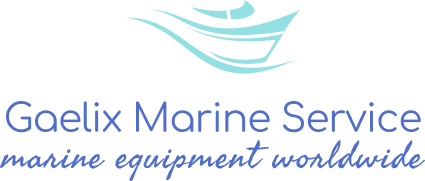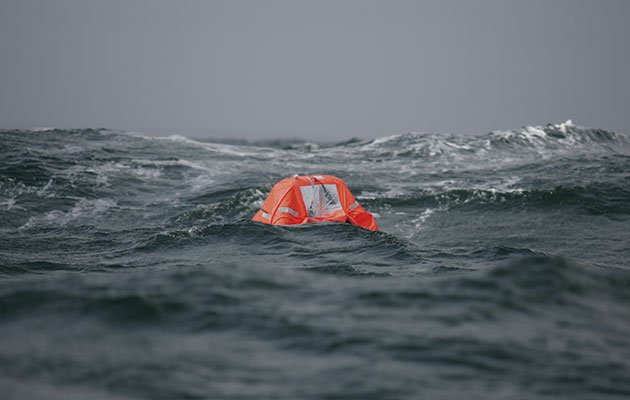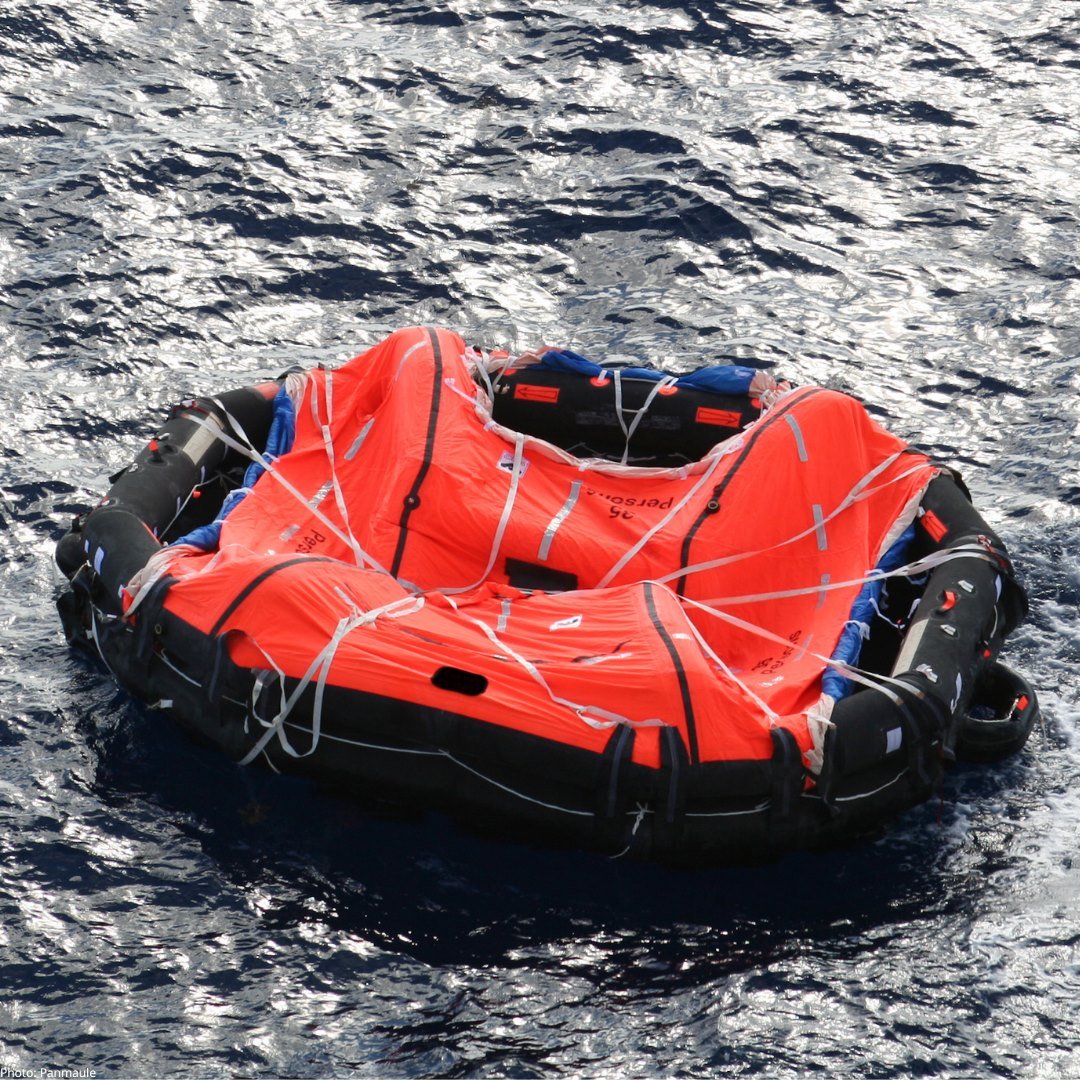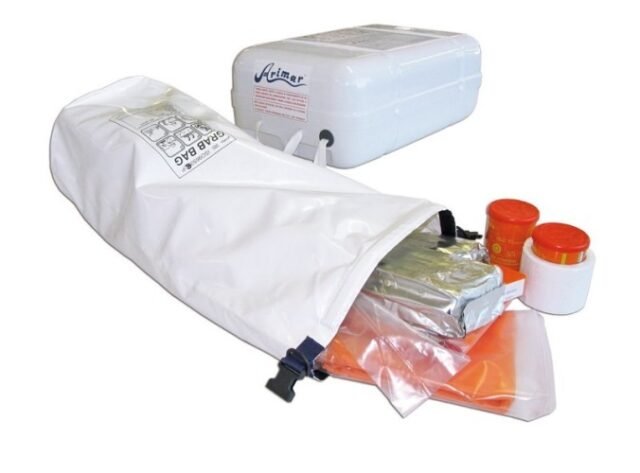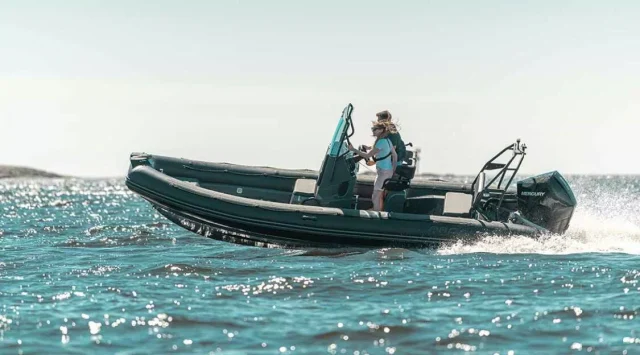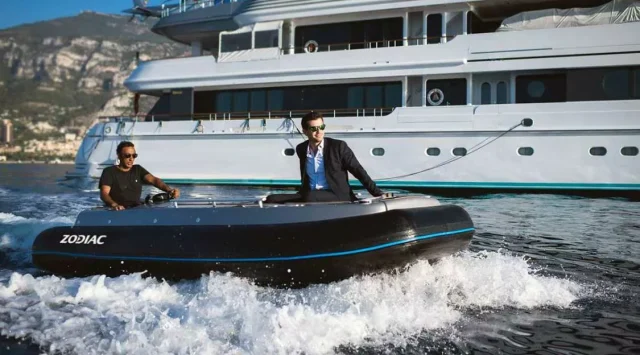| Authors of the photos: Graham Snook/Yachting Monthly, Panmaule, Lalizas
Today, let’s talk about liferafts. When outfitting a yacht, sooner or later, you will need to choose a liferaft as the last resort in case of an emergency. Therefore, it’s important not only to choose the brand but also to understand what exactly you are buying. Key Differences in LiferaftsThe main differences in liferafts lie in their configuration and their ability to right themselves, which is why rafts are divided into regular and self-righting. This is a crucial feature. When a raft is dropped into the water, it should set itself up properly. Similarly, if a self-righting raft is flipped by a wave, it is easier to restore to its normal position.
All rafts for non-commercial vessels are manufactured according to ISO-9650 standards. There are differences in the quality of materials and components, but all of them are certified. Some manufacturers obtain additional certifications from ISAF, RORC, etc., but essentially, they are all similar. Main Differences in ConfigurationThe main difference lies in the configuration, i.e., what is inside the raft. There are three groups for recreational vessels: -24 hours, +24 hours, and SOLAS-B configuration. The first differs from the second by adding a Grab Bag, an additional bag of supplies that is loaded into the raft separately. It is assumed that the crew for whom the raft is designed will be on the raft for less than 24 hours or more, which slightly changes the configuration of the raft: -24 Hour Pack
+24 Hour Pack
Grab Bag
SOLAS B Pack
Cost and Quality Considerations There are many manufacturers, and prices vary significantly. The same raft can cost from 800 to 2000 euros. One of the leaders in terms of quality and price is the Greek company Lalizas, although its products are primarily used by commercial vessels. Lalizas also equips pilot and coast guard vessels with its rescue equipment. Additionally, it is one of the few manufacturers that produce liferafts in Greece, so there is no doubt about the reliability of its products.
The most well-known brands of liferafts for recreational or charter boats and yachts are LALIZAS ISO ATLANTIC and LALIZAS SEAWORLD. You can purchase Lalizas liferafts of any model and in any quantity at wholesale prices from the Gaelix Marine Service online store. Packaging Type and Storage MethodAnother characteristic of a liferaft to consider when purchasing is the type of packaging and storage method. Liferafts can come packed in a plastic container or in a soft valise. The choice depends on your boat and whether there is space to install a container or if it is more convenient to store a valise.
Both types of packaging have their advantages and disadvantages. Usually, the container is installed permanently in a special stainless steel bracket on the stern or on the cabin roof. It is assumed that the raft will be dropped overboard from this bracket, and if a hydrostatic release is installed, the raft should float to the surface if the yacht sinks. However, while this is clear for the stern, throwing a raft weighing about 40 kg in a slippery plastic container from the bow deck, especially in waves and for an exhausted person, is not an easy task. A liferaft in a bag is certainly lighter. It can be stored in a cockpit locker or a special stern locker. It is easier to carry to the leeward side or another convenient place, but launching it will take a bit more time than throwing a liferaft from a stern bracket. Lifespan and ServicingAnother important parameter of a liferaft is its guaranteed storage period, which usually ranges from 3 to 6 years depending on the manufacturer. Before the expiration date, the liferaft must be taken to a service company, which will repackage the raft, replace the air cylinder, pyrotechnics, and supplies. This operation usually costs around 300-500 euros and takes a few days. Why Timely Repackaging is ImportantIt’s crucial to perform timely repackaging because if you ever need to use the liferaft, it might be a one-time necessity. If the raft fails to inflate, there’s no point in having carried it for years. Therefore, if you have a liferaft on board, it must always be in working condition. This also applies to automatic inflatable life jackets, which are very popular among yachtsmen, but that’s a topic for another time. I hope you never need to use your liferaft. |
Aluminum: The Best Material for Boat Hulls
Authors of the photos: German Zeppelin Shipping Company Ltd., Barry Ernest, Nautic Star, Gelex Global Group,
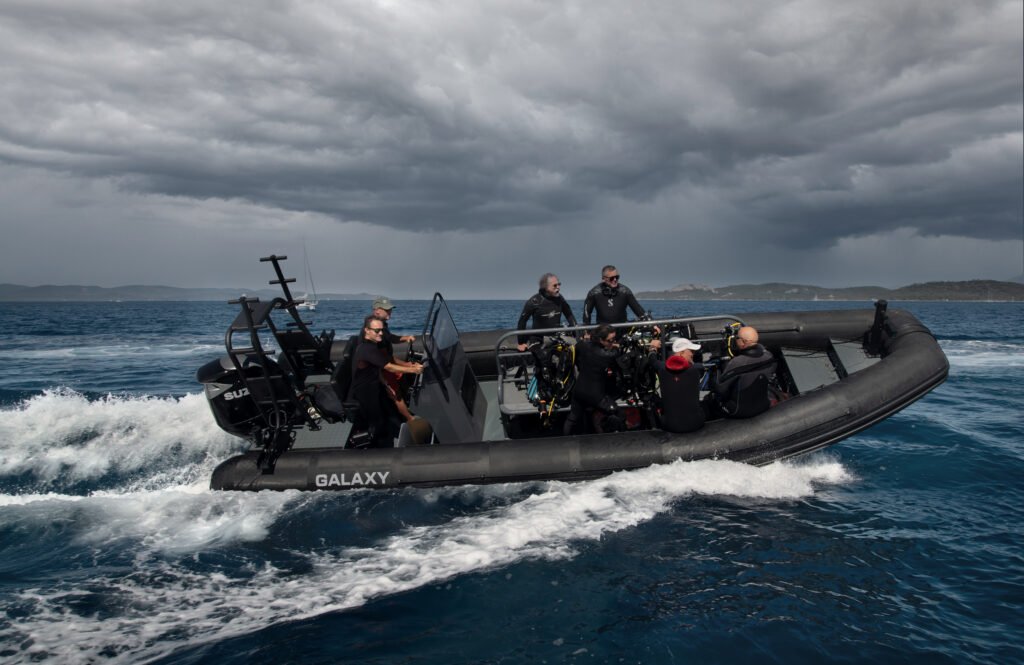
Popularity of the Material
If world history has already seen the “Stone Age,” “Iron Age,” and “Bronze Age,” then our era can confidently be called the “Aluminum Age.” Just two centuries ago, this metal was considered precious, but today it’s hard to name an area where it isn’t used.
Despite being the most abundant metal on Earth, comprising a full 9% of the Earth’s crust, aluminum was practically unused until 1825. At that time, German physicist Hans Christian Ørsted attempted to extract a new metal from the mineral bauxite. Unfortunately, Ørsted’s process for obtaining the new metal was so labor-intensive and costly that it immediately became the most expensive metal in the world—more costly than gold and platinum. Consequently, fashionable ladies of the time quickly adorned themselves with new aluminum jewelry, which sounds amusing from our modern perspective. Subsequently, aluminum was even used by the Wright brothers, inventors of the airplane, to make the engine walls. The metal was also used in the construction of Zeppelin airships. In the future, the aviation industry would fall in love with aluminum for its lightness and reliability.
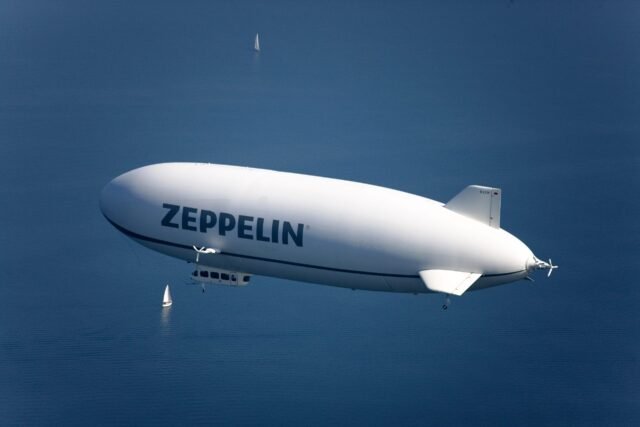
The increased demand for aluminum sharply boosted its production volumes. Methods for mass production were actively sought. One of these methods transformed aluminum from the most expensive to the cheapest metal in the world. Everything changed when German engineer Alfred Wilm invented a way to facilitate the mass casting of aluminum. Although the early results were far from ideal, as the aluminum was very brittle, Wilm’s serendipitous discovery changed everything. Dissatisfied with his aluminum hardening experiments, he left the samples to cool openly, and upon returning a few days later, he noticed that they had hardened, acquiring the desired strength. Thus, in 1906, Wilm invented the process of age-hardening, giving the world duralumin. This led to a drastic reduction in the metal’s cost, which had been considered precious for the past 50 years, dropping the price of aluminum from $1200 per kilogram to $1 per kilogram. This marked the triumphant march of duralumin across the globe.
Alfred calculated the optimal aging temperature for duralumin and the necessary time to achieve ideal structural strength. This made it possible to use aluminum literally everywhere.
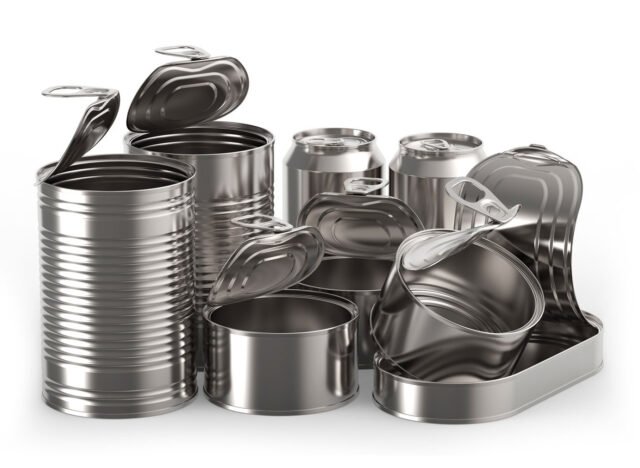
Aluminum has long been firmly embedded in our daily lives: from cutlery, kitchen faucets, and wires, to car bodies, airplanes, and ships. Approximately 23% of the world’s aluminum is used in construction today. For instance, it was the primary metal used in the construction of the famous Empire State Building. However, the main consumers of aluminum worldwide remain the automotive and shipbuilding industries. Thanks to this material, manufacturers have been able to lighten vehicle structures, leading to reduced fuel consumption and lower emissions. Indeed, our world would be very different today without the widespread use of aluminum.
Aluminum: The Best Material for Boat Building

The internet is filled with various opinions on building yacht and boat hulls from steel, aluminum, and other materials. In reality, the choice of aluminum alloys for boat construction is quite limited. Currently, there are six main aluminum alloys used in shipbuilding: 5052-H32, 5083-H321, 5086-H32, 6061-T6, 6063-T6 or T52, and 6262-T6511. The most widely used in shipbuilding is the 5083 grade. This is a marine-grade alloy, the strongest non-heat-treatable aluminum alloy used commercially. It maintains excellent tensile strength in the weld zone and has superior corrosion resistance, making it suitable for both saltwater and freshwater. Often, shipbuilders use a combination of alloys, such as 6061 for hull structures and 5086 for added durability.
Consumers frequently ask whether to choose an aluminum boat or a fiberglass one, or perhaps a combination of both. We have compiled information into a single guide to show the pros and cons of boats made from different materials. Honest and unbiased. Make your choice.
Advantages of Aluminum Boat Hulls
Reliability and Durability: The most significant argument in favor of an aluminum boat is its reliability. For example, aluminum RIBs by “GALA” are made from marine-grade aluminum alloy 5083 and have excellent longitudinal and transverse rigidity.
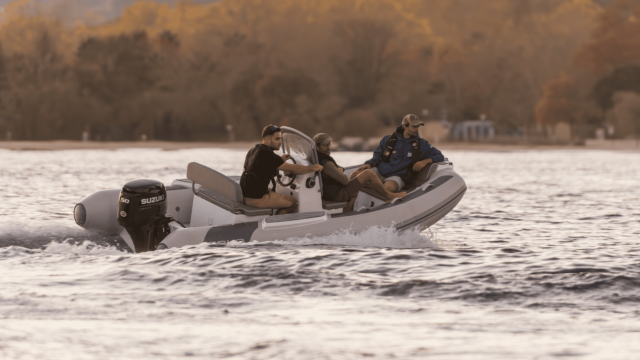
The hull thickness typically ranges from 2.5 to 4.5 millimeters, making the boat virtually indestructible. The additional corrosion protection of aluminum surfaces, through chromium-free titanium passivation using the ENVIROX system, makes GALA RIBs almost eternal. Aluminum boats in certain sizes always weigh less than fiberglass boats, while maintaining a rigid structure that can withstand impacts with various rocks. You can also more comfortably land on unprepared shores and navigate shallow waters with an aluminum boat.
Versatility: All models of GALA aluminum RIBs are versatile and can be used for fishing, leisure, and other water activities. The GALAXY aluminum RIBs are specifically designed for use by police, coast guards, water rescue teams, the military, etc.
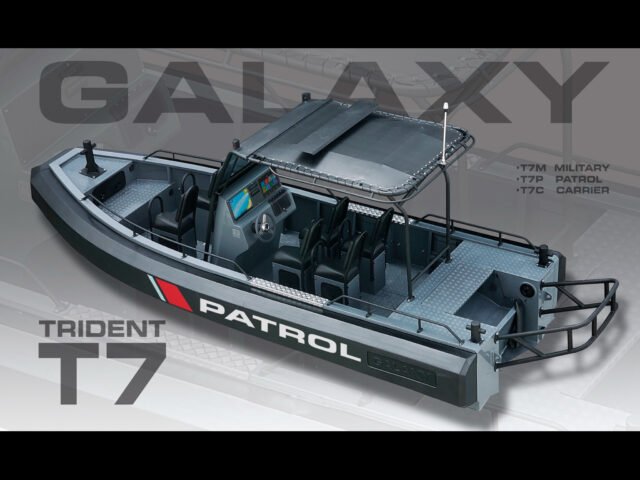
Resale Value: When you buy a new GALA or GALAXY aluminum boat, you can sell it a few years later for nearly the same price. The hull ages very slowly, and the resale value of an aluminum boat in the secondary market is almost unchanged.
Combined Aluminum and Fiberglass Boats
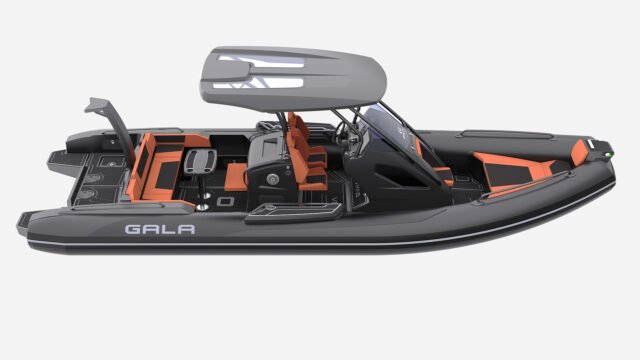
The main hull of GALA RIBs is made from aluminum, but in the Gala Viking models, some elements, such as steering consoles and seat pedestals, are made from fiberglass. This combination results in a beautiful, convenient, lightweight, strong, and reliable boat structure.
Disadvantages of Aluminum Boats
There are practically none. However, the only downside that comes to mind is the complexity of repairs and the higher initial purchase price compared to fiberglass boats. But this cost is more than compensated by the reliability, durability, safety, and many years of enjoyable time on the water.
Conclusion
Experts note that if finances allow, most potential boat buyers would be happy to own two boats. The first would be an aluminum RIB for fishing and other water activities, such as the GALA ATLANTIS, and a comfortable boat for traveling.
What is RIB? Top 10 best RIB manufacturers.
Characteristics and primary producers of hybrid vessels combining rigid hulls and PVC construction materials.
Authors of the photos: Jan van der Wolf, Wikipedia, Pirelli, Tecnorib, Zodiac Nautic, Brig, Gelex Global Group, Williams, AB Inflatables, Castoldi, Technohull, SACS, Novamarine.
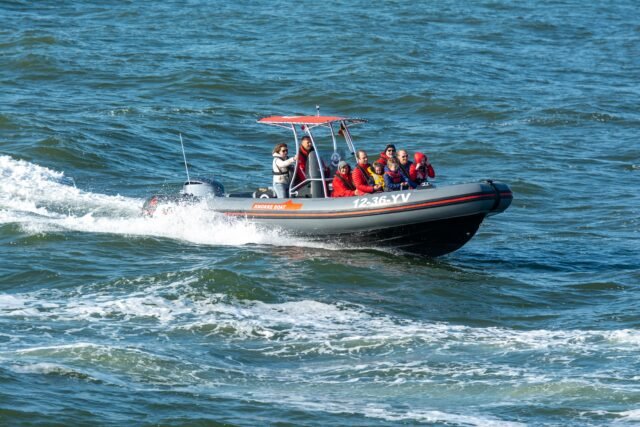
In the realm between traditional inflatable boats and rigid-hull vessels lies a unique hybrid known as rigid-inflatable boats (RIBs), or sometimes referred to as “rigid-modular” boats. These vessels, distinguished by the English abbreviation RIB (rigid inflatable boat) or RHIB (rigid-hulled inflatable boat), amalgamate the finest attributes of both counterparts. In this article, we delve into the genesis of RIBs, their distinguishing features, and avenues for acquiring such exceptional watercraft.
How did RIBs come about?
The inception of RIBs traces back to the late 1960s, originating in the maritime innovation hub of the United Kingdom. Developed at the behest of the nation’s Navy and subsequently embraced by the Royal National Lifeboat Institution, RIBs emerged as a testament to maritime engineering ingenuity. Though the founding patents eluded him, Tony Lee-Elliott, the visionary behind the Flatacraft shipyard, spearheaded the conceptualization of RIBs as early as 1965, laying the foundation for their future prominence.
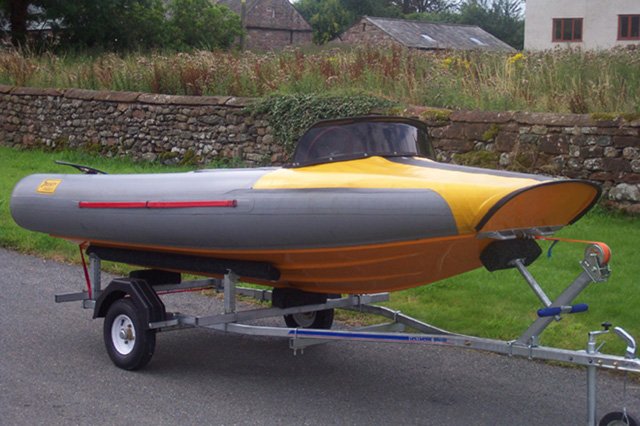
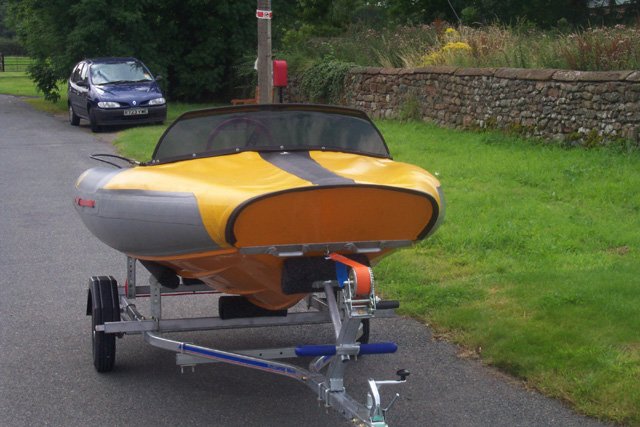
Initially, RIBs manifested as either conventional vessels outfitted with rigid hulls complemented by inflatable tubes or inflatable crafts fortified with reinforced bottoms. Among the pioneers in serial production of RIBs, Avon Inflatables stands tall, paving the way for the proliferation of these innovative watercraft.
What are RIBs like today?
In contemporary times, the RIB landscape flourishes with an eclectic array of models from diverse manufacturers. Varying in size, configuration, and amenities, RIBs cater to a broad spectrum of preferences and budgets. The pinnacle of RIB opulence is epitomized by “super RIBs,” luxurious cabin cruisers exceeding 20 meters in length, heralding a new era of maritime indulgence.
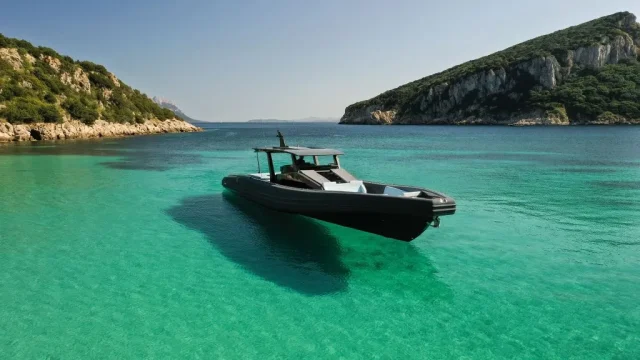
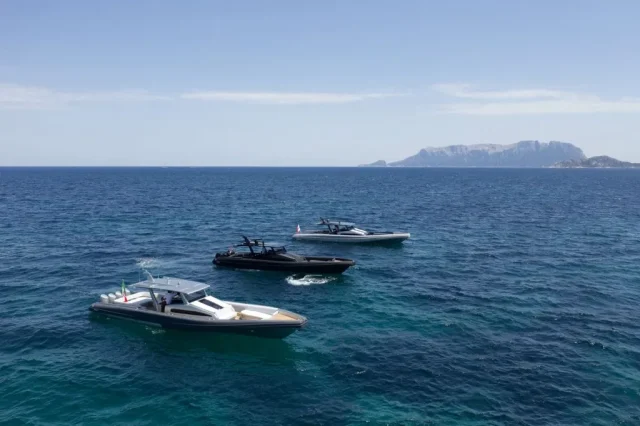
Celebrated for their unparalleled attributes, RIBs have garnered acclaim among military, special services, and aquatic aficionados alike. Modern RIB construction harnesses cutting-edge techniques such as vulcanization, gluing, and ultrasonic welding to seamlessly integrate rigid hulls crafted from plastic or aluminum with inflatable tubes, ensuring optimal durability and reliability.
The merits of RIBs are manifold, encompassing advantages associated with both the rigid hull and the inflatable tubes. The rigid hull confers benefits such as shallow draft, puncture resistance, and the potential for installing enclosed superstructures, facilitating high-speed performance and enhanced maneuverability. Meanwhile, inflatable tubes serve as buffers against wave impacts, ensuring safety in tumultuous seas, and augmenting the vessel’s load-bearing capacity.
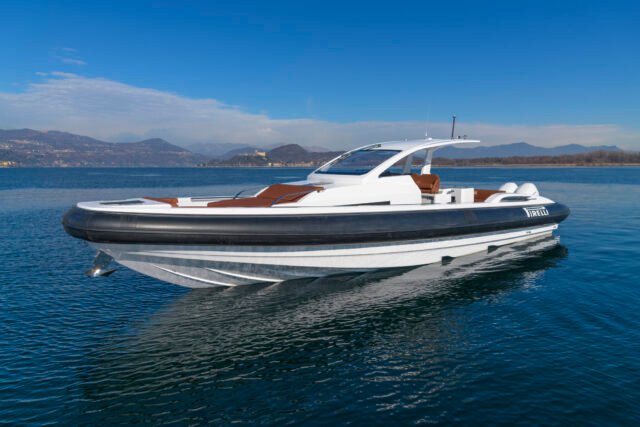
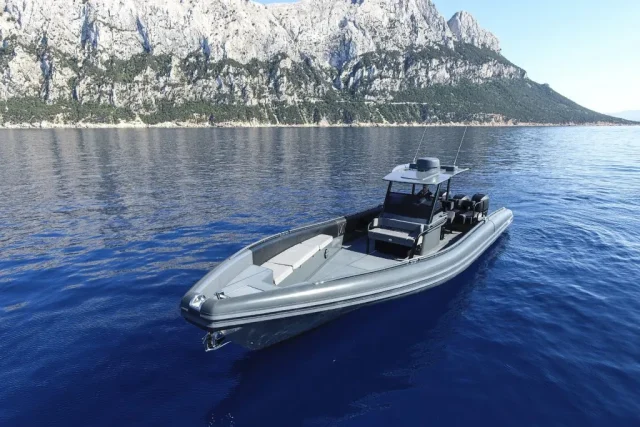
While RIBs boast an array of advantages, they are not without their limitations. Some models may exhibit considerable weight, necessitating transport via trailer, and constraints in internal space. Nonetheless, the allure of RIBs transcends these drawbacks, making them an unparalleled choice for embarking on aquatic adventures of unparalleled splendor.
Who are the main RIB manufacturers?
Zodiac
This French shipyard is not only a leader in the RIB market but also one of the oldest players in this segment. In 2021, the company will celebrate its 125th anniversary. Although the firm initially did not specialize in boats, instead focusing on aircraft, the engineer of the company presented a unique “prototype” of modern Zodiac vessels back in the 1930s.
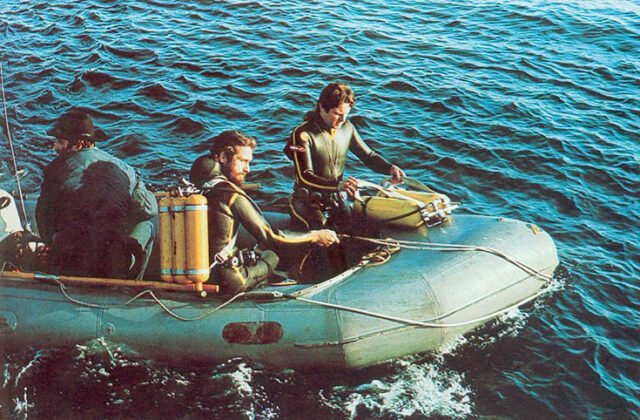
In the 1970s, Zodiac particularly favored Jacques-Yves Cousteau’s boats.
Today, Zodiac Nautic produces models ranging from 3.6 meters (4-seat Yachtline 360) to 8.5 meters (PRO 850, designed for 25 people). The shipyard offers boats for simple transfers of people and goods from yachts to shore, as well as for comfortable leisure on the water, fishing, and diving. Depending on the model, the base price of the boat ranges from €17.5 thousand to €64.6 thousand.
A standout model is the eJET 450.
This 4.5-meter fully electric RIB is designed for seven passengers. At an average speed of 24 knots, the boat can autonomously operate for 1.5 hours.
If cruising at a leisurely 5 knots, the battery will last for 8 hours. The maximum speed achievable by the eJET 450 is 30 knots. The base price of the model is €125 thousand (including VAT). Zodiac takes pride in its automated thermowelding process and its patented super-strong material, Strongan Duotex, which surpasses PVC in strength.
Brig
The origins of the Ukrainian Shipyard Brig can be traced back to the aviation industry, similar to Zodiac’s trajectory. Vyacheslav Rodionov, the company’s founder, brought together a team of aviation engineers in Kharkiv who found themselves unemployed after the collapse of the USSR. Together, they ventured into the production of inflatable boats and RIBs. Over the course of 27 years, Brig has emerged as a prominent player in the global RIB manufacturing landscape.
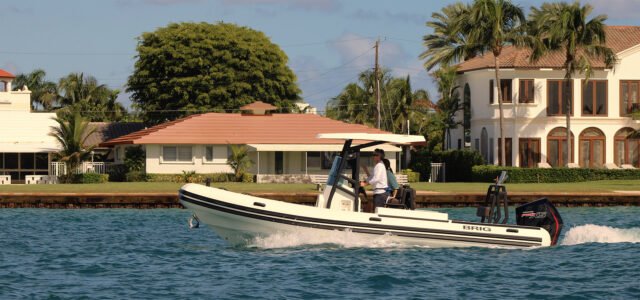
With a lineup of 22 models ranging from the compact 2.9-meter Falcon Tender 300 to the spacious 9.95-meter Eagle 10, capable of accommodating 12 passengers, Brig offers a diverse range of options. These models are categorized into four distinct lines, each offering unique features such as enhanced maneuverability, improved stability on rough waters to minimize splashing, and energy efficiency for economical fuel consumption during water sports activities. Prices vary depending on the model, starting from €10 thousand and reaching up to €200 thousand.
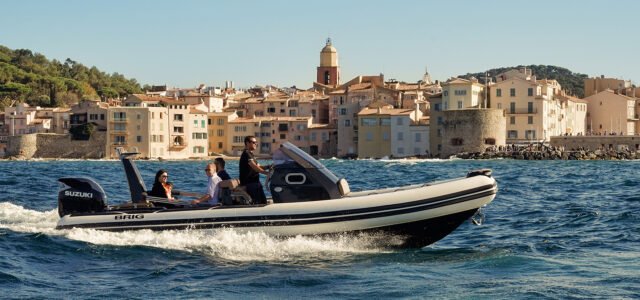
In 2020, Brig’s flagship vessel was nominated as a finalist for the Motor Boat Award but was ultimately surpassed by its younger sibling, the 7.9-meter Eagle 8.
Gala
Gala is a distinguished brand with Ukrainian origins, born from a collaboration between the esteemed Canadian company GRAND MARINE GROUP and the Ukrainian GELEX GLOBAL GROUP. While Gala’s journey commenced in 2014, a notable transformation occurred within the company in 2022. This transformation saw the integration of four distinct brands – GALA, GALAXY, GELEX, and RIVERDAY – into the GELEX GLOBAL GROUP, all while proudly upholding their Ukrainian heritage.
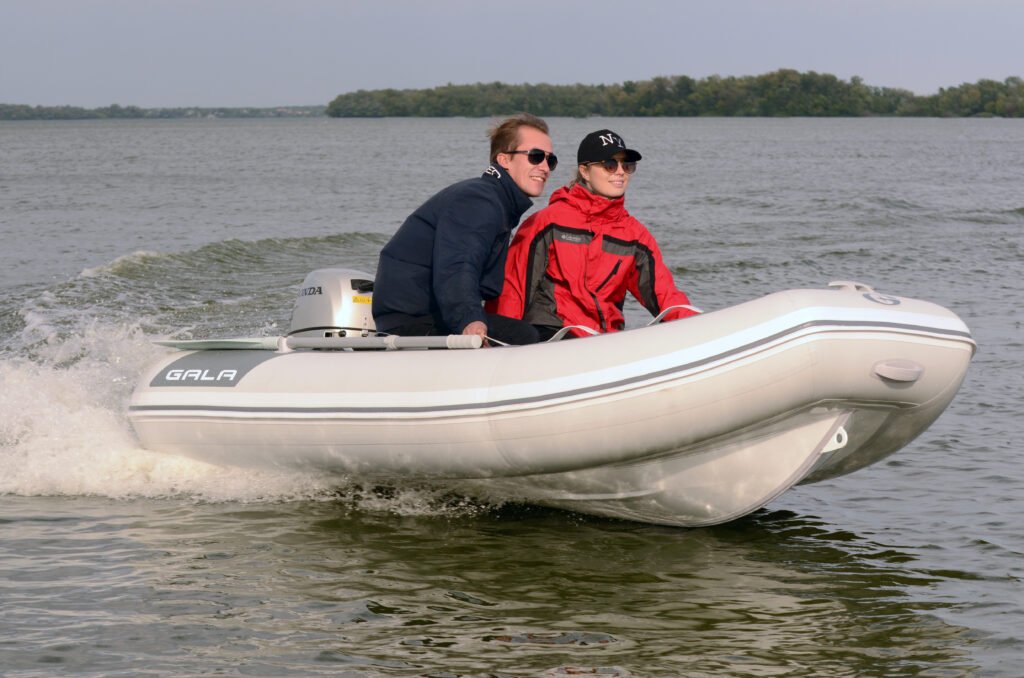
Gelex Global Group has emerged as a beacon of modernity, demonstrating precision and excellence across every stage of its production process. From their cutting-edge design office to their meticulous quality assurance department, and from their advanced rotational molding technology to their surface waterproofing division, innovation and sophistication permeate every aspect of their operations. Moreover, their commitment to excellence extends to safeguarding aluminum products from corrosion through a state-of-the-art passivation line.
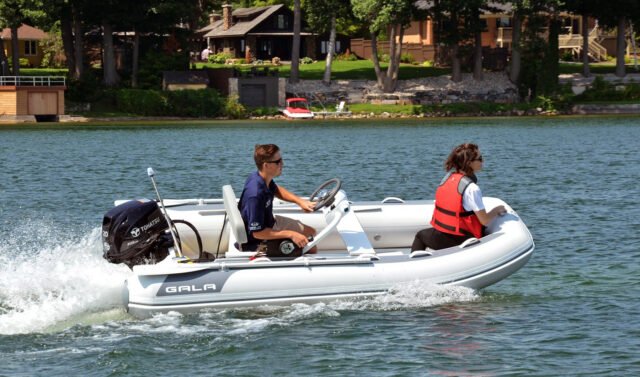
The primary focus lies in developing an enhanced line of inflatable boats featuring aluminum hulls and folding configurations. Since 2019, Gala has been unveiling an impressive range of GALAXY inflatable boats tailored for professional applications, including search and rescue, law enforcement, military, and diving operations. Offering a diverse array of Gala and Galaxy inflatable boats ranging from 2.1 to 8 meters in length, the company caters to various market segments.
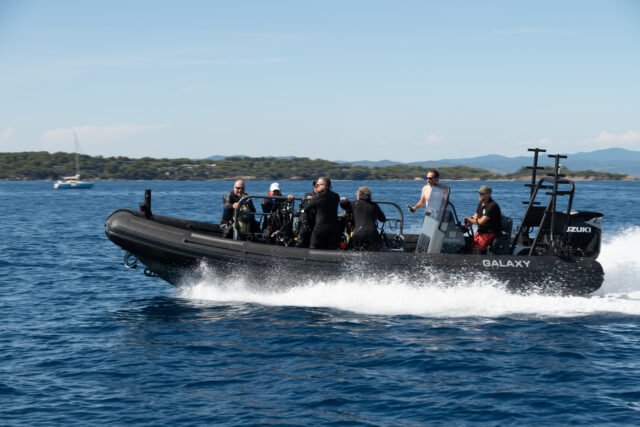
GALA’s inflatable boat collection offers a diverse range of models to suit various needs:
ATLANTIS Lite: Lightweight RIB tenders with aluminum hulls.
ATLANTIS Dual-deck: RIB tenders featuring dual decks and aluminum hulls.
ATLANTIS Aquahelm: Compact tenders with console steering and aluminum hulls.
ATLANTIS Deluxe: Premium RIB tenders with aluminum hulls, central consoles, and remote steering.
VIKING Tenders: High-quality aluminum RIB tenders.
VIKING Cruising: Top-tier aluminum cruising RIB boats.
Prices vary depending on the model: from 2,300 to 72,000 euros.
In addition, GALAXY offers a professional lineup including:
GALAXY PILOT: Professional-grade inflatable boats with traditional inflatable tubes.
GALAXY TRIDENT: High-caliber inflatable boats designed for professional applications, featuring D-shaped tubes with options for foam coating or inflatable floats.
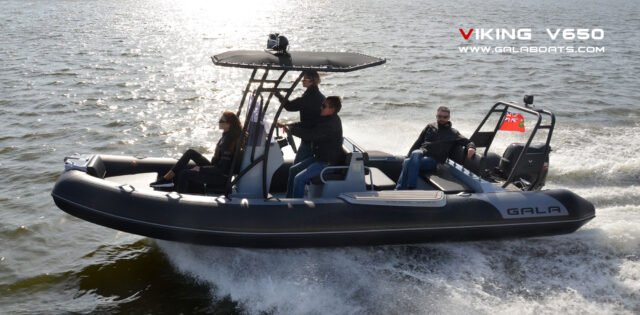
Williams
Since 2002, Williams has been a key player in the tender market, specializing in crafting RIB boats. Their extensive range comprises 14 models, spanning from the compact Minijet 280, measuring 2.79 meters, to the expansive Evojet 70, stretching 7 meters.
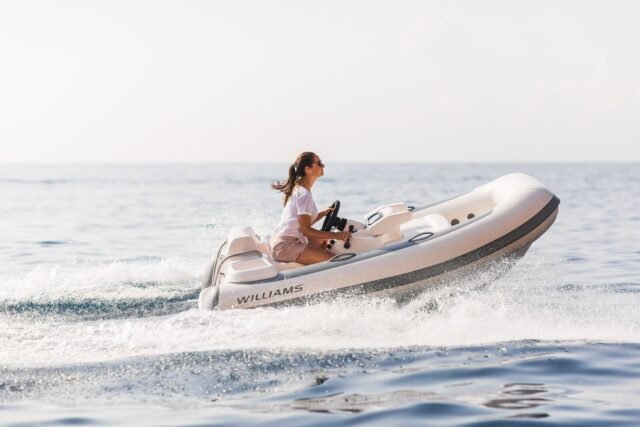
Designed to comfortably accommodate between 3 to 13 individuals, these boats are priced between €21 thousand to €208 thousand, VAT inclusive. Williams offers five distinct boat lines, catering to a spectrum of needs, from tendering to high-performance water sports vessels.
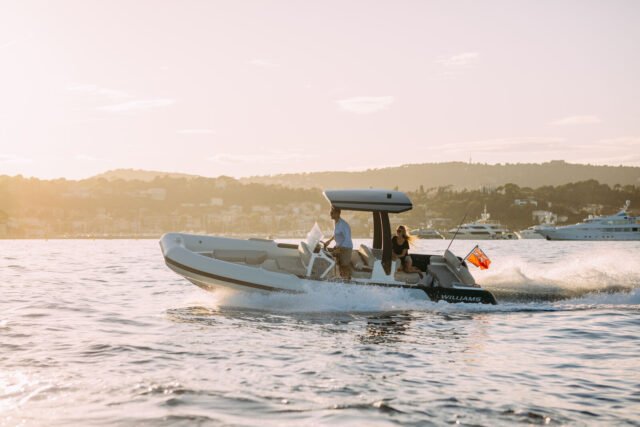
A notable feature of Williams is their user-friendly website, featuring an online configurator. Prospective buyers can seamlessly explore available options and tailor their preferences before finalizing a purchase.
AB Inflatables
Originating from Colombia, AB Inflatables is renowned for its versatile range of RIB boats suitable for leisure and professional purposes alike. Setting them apart is their production of aluminum RIB boats alongside the more common fiberglass models.
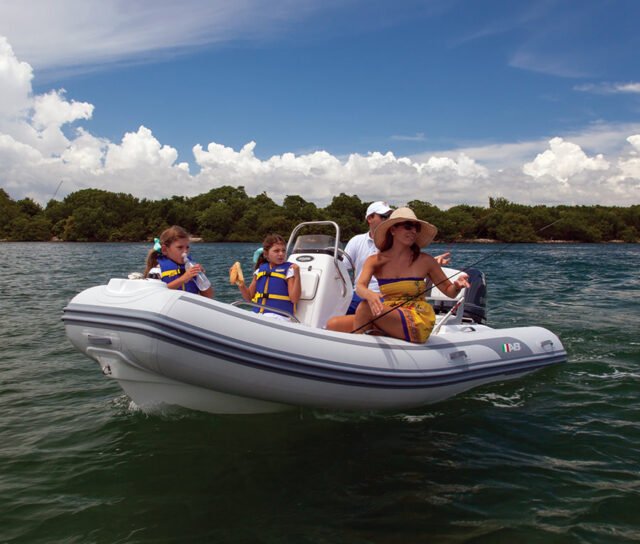
With a comprehensive lineup comprising 16 lines and 85 models, ranging from the compact Lammina 7.5 UL to the spacious Oceanus 28 VST, AB Inflatables offers boats accommodating between 3 to 25 individuals.
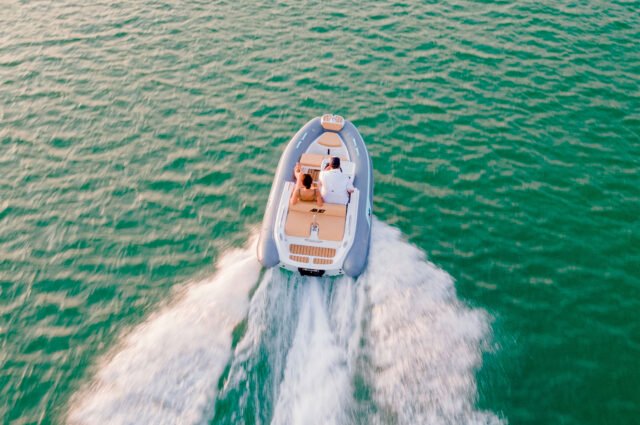
Base prices for these boats can peak at €117 thousand. Noteworthy is the significant portion of AB Inflatables’ RIB boats serving as rescue vessels and special service crafts, with offerings ranging from simple dinghies to boats ideal for leisurely day trips.
Castoldi
Boasting a heritage dating back to 1930, the Italian shipyard Castoldi specializes in crafting luxury RIB boats equipped with inboard engines.
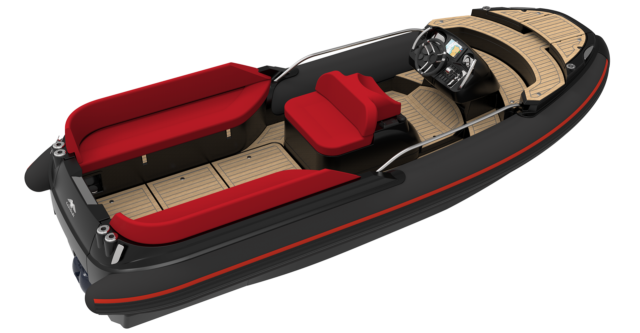
Their lineup of 11 models caters to diverse preferences, from the intimate 7-seater Jet Tender 14 to the capacious Jet Tender 27 designed for 16 individuals. Castoldi boats excel as tenders and towboats for water sports activities, offering a blend of comfort and functionality.
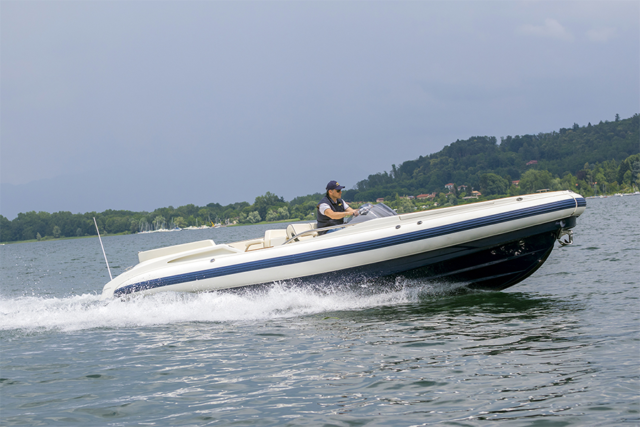
Additionally, certain models feature hard-hulled designs with minimal inflatable tubes, suitable for venturing into deeper waters. Notably, Castoldi produces models compliant with the International Convention for the Safety of Life at Sea (SOLAS), certifying their suitability for use as lifeboats.
Technohull
Distinguished for its focus on high-performance cabin RIBs, the Greek shipyard Technohull offers models ranging from 7.2 meters to 13.8 meters in length.
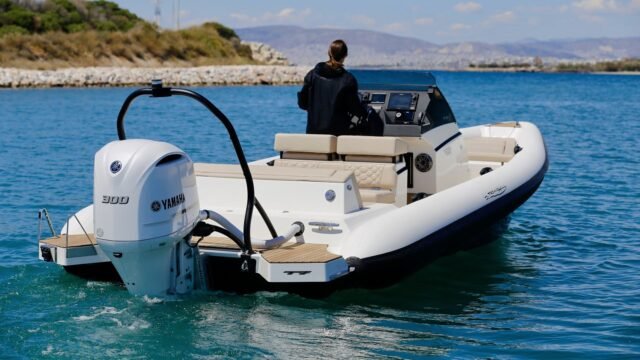
Their lineup of seven models delivers unparalleled speed and agility, with even the smallest model capable of reaching speeds of up to 56 knots.
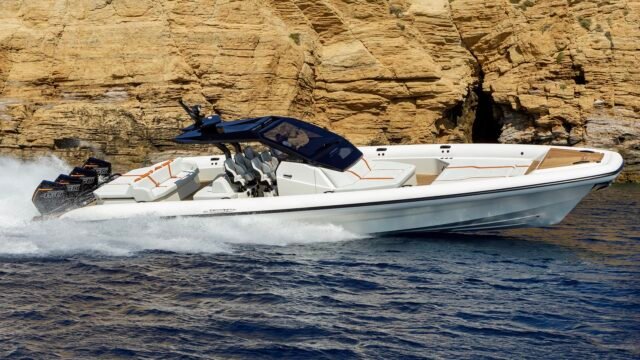
Maintaining impressive fuel efficiency at a consumption rate of only 0.8 liters per nautical mile, Technohull models can be priced up to €480 thousand. Like Williams, Technohull offers an online configurator on their website for effortless customization.
Tecnorib
As a subsidiary of renowned tire manufacturer Pirelli, Tecnorib adheres to the highest standards of quality and craftsmanship. Partnering with Novamarine and SACS, Tecnorib stands as a premier supplier of luxury cabin RIBs.

Their lineup of 18 models, categorized into four lines, caters to a broad spectrum of preferences and needs. From straightforward tenders to potent high-speed boats, Tecnorib offers versatility and performance.
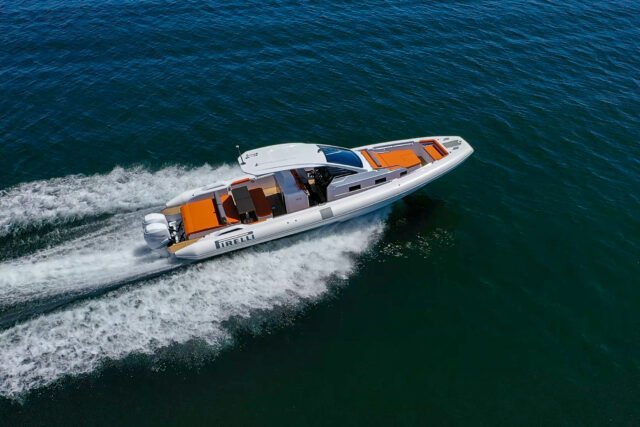
Notably, their models are replicated in a special version developed in collaboration with Azimut for Azimut yachts. With base prices exceeding €1 million for their largest and most opulent models, Tecnorib reflects an unwavering commitment to exceptional quality and luxury features.
SACS
The esteemed Italian shipyard SACS has a storied history in the contemporary RIB market, tracing its origins back to 1989. Presently, it boasts an eclectic portfolio comprising 11 models neatly divided into two distinct lines.
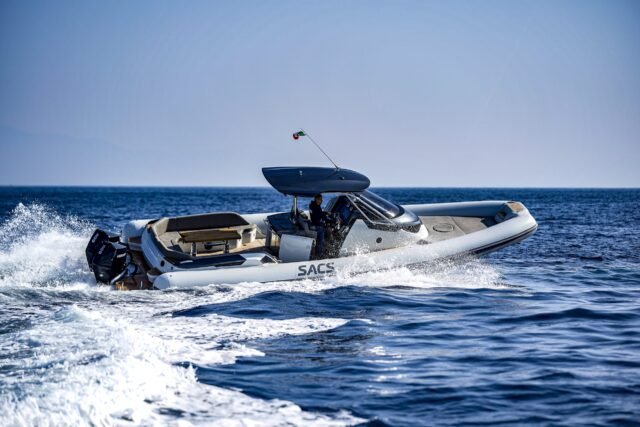
However, SACS goes beyond the ordinary with its offerings. A specialized division within the company is committed to delivering tailor-made customization services for boats, showcasing innovative features like hull extension, as exemplified by the remarkable Strider 20. Collaborating with esteemed automotive brands such as Ferrari, Jaguar, Abarth, and Lancia, many of these bespoke models redefine luxury on the water.
Standing out in SACS’s standard model range is the compact yet versatile Strider 700, measuring a mere 6.96 meters.
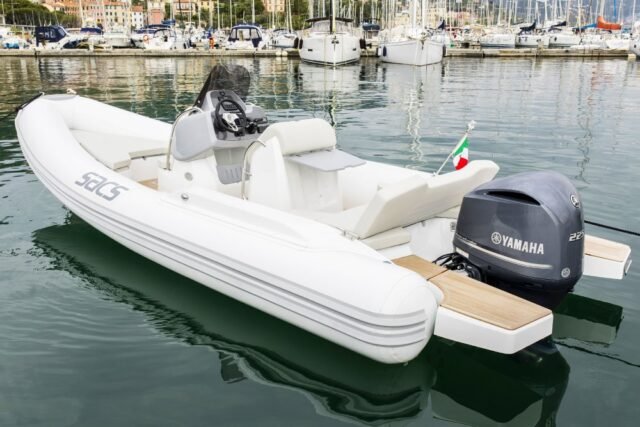
Despite its modest size, this RIB comfortably accommodates up to 16 individuals, demonstrating exceptional versatility. Leading the fleet is the Strider 19, an imposing vessel spanning 18.13 meters and designed to host up to 22 passengers. Notably, this flagship model outperforms even the Tecnorib Pirelli 1900 in acceleration, achieving speeds of up to 50 knots. SACS boats start at a base price of €83 thousand.
Novamarine
Another illustrious figure in Italian shipbuilding, Novamarine has been a pioneer in RIB manufacturing since the 1980s, contributing significantly to the evolution of these vessels. Today, the company distinguishes itself by categorizing 90% of its product lineup as a distinct class of vessels, as opposed to traditional RIBs, on its official website. This distinction stems from Novamarine’s innovative use of foam material blocks instead of conventional inflatable tubes, while visually, its models remain indistinguishable from other RIBs.
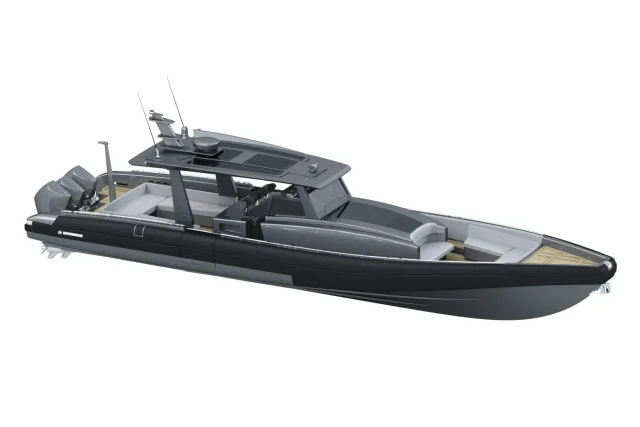
Novamarine’s offerings span three distinctive lines, comprising a total of 11 boats ranging from the nimble 8-meter RH800, capable of reaching speeds of up to 50 knots and accommodating 12 passengers, to the commanding 22-meter Black Shiver 220, capable of hosting up to 30 individuals. These vessels are meticulously crafted to cater to both leisure and semi-professional usage scenarios.
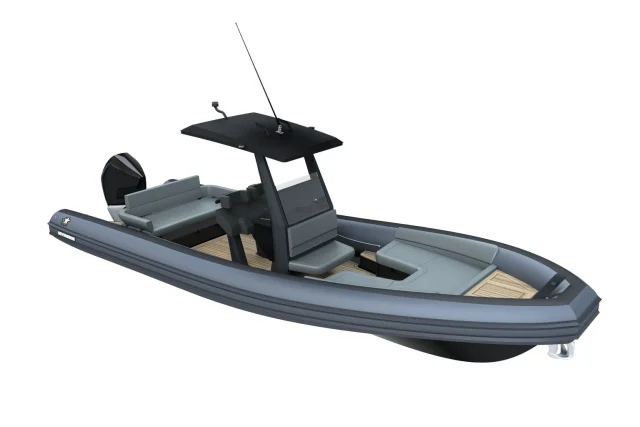
With prices starting at €2,5 million, Novamarine boats exemplify the epitome of luxury and performence in the industry.
Additionally, Novamarine operates a dedicated production line catering to the Defence series of RIBs, specifically engineered to meet the rigorous demands of military applications.
Let’s summarize.
The realm of rigid inflatable boats presents an extensive spectrum of options catering to a multitude of needs and preferences. Each shipyard, be it Williams, AB Inflatables, Gala, Technohull, SACS, or Novamarine, brings its distinct touch, offering a diverse lineup ranging from compact tenders to opulent high-speed crafts.
Williams distinguishes itself with its emphasis on lightweight construction and efficiency, while Gala pioneers an inventive approach to materials. Castoldi stands out for its focus on luxury and bespoke customization. Technohull and Tecnorib excel in prioritizing speed and performance, whereas Galaxy showcases technological advancement through the utilization of foam.
Irrespective of individual inclinations, the domain of rigid inflatable boats ensures the availability of an ideal vessel tailored to fulfill one’s desires, whether for leisurely pursuits or professional endeavors.
Planing or displacement yacht. What to choose?
A clear and concise analysis of various types of yacht hulls.
The behavior of a yacht on water and its usability depend directly on the type of hull. When choosing a yacht, it’s essential to determine which hull type suits your specific needs. In this article, we’ll list the main types of hulls existing today and clearly illustrate their differences.
Two main types of hulls using the example of a knife and a box.
The development and improvement of hulls aim to reduce the hull’s resistance when moving through the water. All hulls experience wave resistance, overcome frictional force, as well as resistance from form, aerodynamics, induction, and spray. Each design copes with these forces differently. Let’s consider how different designs behave in water using the example of a knife and a box. Imagine placing them in a pool as if they were two boats. The knife easily cuts through the water, even in waves. However, it doesn’t float, and its size doesn’t allow anything to be loaded onto it. In contrast, the box behaves differently: it floats well, even with a load, but it rocks on waves, especially when stationary, and in motion, such a hull will be hit by each wave with its full width.
Of course, this is a very rough comparison, but it accurately describes the behavior of the hull in water depending on its shape and the tasks faced by yacht designers. It’s intuitive that for faster speeds, a narrow hull that easily cuts through the water and creates minimal resistance is needed, but for comfortable accommodation of a large number of people, something box-like resembling a barge would be suitable.
The key is to combine the advantages of the “knife” and the “box” in one hull.
The more the hull’s shape resembles a “knife,” the faster the yacht, and the more it resembles a “box,” the more spacious and comfortable it is. Roughly speaking, a “knife” is a planing hull, and a “box” is a displacement hull. These are the two poles in yacht design. Between them, there are transitional types of hulls, and within them, there are subtypes depending on the shape of the bottom and the lines of the sides.
Advantages and Disadvantages of Displacement Hulls
Remember the school rhyme to remember Archimedes’ law, which allows bodies not to sink in water? “A body immersed in water displaces a volume equal to the volume of the body, with a force equal to the force of the displaced water.” In the case of displacement boats, Archimedes’ force is the main force acting on the yacht. Balanced Archimedes’ force and the force of gravity suspend the hull in the water, much like a buoy. So when moving, it simply pushes through the water due to the momentum received from the propeller or sails.
To make it easier for a yacht to push through the water, the shape of the hull below the waterline is often made round, smooth – to minimize water friction. They resemble ideally polished sea pebbles through which water passes without stopping. Only the yacht’s bow is made sharp to cut through the water like a knife, without raising a large wave. Even if the hull’s construction occasionally involves sharp edges (when the contours resemble a faceted glass), they are directed so that they intersect the waterline at the bluntest angle possible or don’t intersect it at all. After all, any extra angles and recesses create unwanted whirlpools, which slow down the boat.
The biggest limitation of yachts with displacement hulls is their speed. The formula for calculating the maximum speed of a displacement hull would look like this:
![]()
Here,
Lwl represents the length of the vessel at the waterline in feet.
Vmax represents the maximum speed of the vessel in knots.
Simply put, the speed of a displacement hull is limited by its length.
Of course, installing an extremely powerful engine can make the yacht go faster, but most of the “extra power” will be used to overcome resistance, as the hull is not designed for high speeds and will start “plowing” through the water, pushing a waves ahead of it.
As the speed increases linearly, the required power increases cubically. For example, to double the speed of a displacement yacht, the engine power needs to be increased by eight times. And to triple the speed, the power must be increased by 27 times.
To reduce wave resistance, a bow fairing of the boat is pear-shaped form is applied. It is positioned below the waterline and forms its own wave system, which overlays the hull’s wave system and reduces its impact.
Displacement boats significantly lag behind planing boats in speed when comparing vessels of the same size.
BUT HERE LIES THE GREAT ADVANTAGE OF DISPLACEMENT YACHTS: THEY ARE MUCH MORE FUEL-EFFICIENT AND PROVIDE GREATER COMFORT FOR EMBARKING ON LONG CRUISES AND NAVIGATING LONG DISTANCES.
The low speeds of displacement hulls significantly reduce the skipper’s ability to avoid an approaching storm or escape from a thunderstorm. At low speeds, it’s more challenging to navigate through heavy seas. Additionally, you won’t be able to maneuver between waves, which could significantly enhance safety and facilitate transitioning in bad weather conditions.
Displacement hulls also face the challenge of typically having a deeper draft compared to planing hulls, which restricts their maneuverability in shallow waters.
WHILE PLANING YACHTS MIGHT THEORETICALLY EVADE ADVERSE WEATHER CONDITIONS, IN THE EVENT OF A STORM, YOU’D PREFER TO BE ABOARD A YACHT WITH A DISPLACEMENT HULL.
For longitudinal stability on waves, which rock the boat sideways, the correct ratio of hull length to width is required. For example, for boats ranging from 6 to 12 meters in length, the hull length should be 3.5–4.75 times greater than its width. A displacement yacht sails steadily on the water, without a heel to the stern (longitudinal inclination of the hull to the corresponding side), allowing travel to continue even in bad weather.
SUCH YACHTS DO NOT FEAR EITHER ROLL OR PITCH, WHERE THE BOAT LIFTS BOTH THE BOW OR THE STERN.
To maintain the boat in a normal position, it is not necessary to apply much additional effort. There can be a lot of cargo on board (including passengers), and it can be distributed relatively freely across the yacht. Although the occurrence of heel (sideways tilt) or sternward heel is undesirable, even in this case the vessel will be able to continue moving. The weight of the boat itself also plays a minor role. With planing yachts, things are different.
Sea Boats: Types and Features

Authors of the photos: Gelex Global Group, Allures Yachting
Boats designed for marine environments are among the leading water transport means due to their popularity. They offer extensive opportunities for recreation, sports, and commercial activities at sea. In this review, we will explore the main types of sea boats and their key characteristics, as well as discuss the advantages of RIB boats from the company “GALA.”

Main Features of Sea Boats
High Hull Strength Boats capable of navigating marine zones must have high strength, which is one of the main criteria when choosing this type of transport. The material of the hull, the thickness of the side and bottom walls, and the quality of welding all affect the rigidity and reliability of the hull. For instance, lightweight and reliable leisure RIBs by Gala and professional Galaxy boats use aluminum alloy EN AW-5083H111, renowned for its high strength and exceptional corrosion resistance in seawater. Welding of EN AW-5083H111 alloy using TIG (Tungsten Inert Gas) and MIG (Metal Inert Gas) methods ensures high joint strength. This is especially important for creating durable hulls capable of withstanding extreme loads in harsh operating conditions. The use of special alloy and modern hull welding technology ensures safety at sea, where boats are subject to various mechanical stresses.
Corrosion Resistance

In the aggressive marine environment, corrosion is a serious problem for any vessel. Aluminum, which is often used for RIB hulls, has excellent anti-orrosion properties that protect it from corrosion. However, advanced brands like Gala and Galaxy go a step further by using chemical treatment of aluminum called passivation. This special protection of aluminum surfaces from corrosion involves the use of a non-chromate titanium passivation system called ENVIROX. The ENVIROX passivation system with titanium creates a protective layer on aluminum hulls. This innovative approach not only reduces the harmful environmental impact by replacing chromates with eco-friendly components but also ensures high corrosion resistance. Safety Ensuring maximum safety is a priority for sea boat manufacturers. This is achieved through modern navigation systems, safety equipment, and the use of other innovative technologies.
Ease of Handling

Handling marine boats is extremely simple and intuitive. This makes them accessible even to beginners, allowing for quick learning of handling and maneuvering on the water. Advantages of Gala RIBs for Coastal Sea Zones Comfort and Reliability RIBs from the “Gelex Global Group” are deservedly popular among water adventure enthusiasts due to their strengths – reliability and comfort. This is especially important for people who value their time and want to enjoy boat trips with minimal repair and maintenance costs.
Appearance

The impressive and solid appearance of Gala boats emphasizes the prestige and social status of their owners, making each RIB not just a means of transportation, but also a status accessory. Wide Range of Additional Equipment Moreover, all Gala and Galaxy models have a wide range of additional equipment and accessories to meet the needs of every owner. These can include various accessories to enhance comfort on the boat, navigation equipment, sailing tents, communication systems, and much more. We will install any additional equipment on your boat. Speed The ability of GALA aluminum RIBs to reach high speeds, combined with excellent stability, allows them to easily navigate the seas. Economy Fuel economy at high cruising speeds is one of the main advantages of aluminum boats since it is well known that aluminum boats are lighter than fiberglass counterparts of the same size. This allows aluminum boats to use less powerful engines. For example, the recommended engine power for the Gala Atlantis Deluxe A500L RIB is 70 HP, while a fiberglass RIB of the same size, such as the Grand G500, requires a more powerful engine – at least 90 HP.
Light Weight of Aluminum Boats

Aluminum boats are lighter compared to boats made from other materials such as steel or fiberglass, which facilitates their transport and maneuvering. The lightness of the material reduces fuel consumption, making boat operation more economical. Additionally, the reduced weight eases the process of launching and retrieving the boat from the water, and, if necessary, towing on a trailer.
The main advantages of the lightweight nature of aluminum boats include:
Ease of Transportation:
The lighter weight of the boat simplifies its transport on a trailer and allows for the use of less powerful vehicles for towing.
Fuel Efficiency:
Due to their low weight, boats require less energy to move, reducing fuel consumption and operating costs.
Convenience in Operation:
Lightweight boats are easier to launch and retrieve from the water, which is especially convenient for boats used as tenders on large yachts.
Improved Maneuverability:
A lightweight boat hull ensures better maneuverability and handling, which is important for safe navigation and quick response to changing water conditions.
Ease of Maintenance:
Lightweight aluminum boats are easier to maintain and repair, contributing to their longer lifespan and reduced maintenance costs.
Conclusion

Aluminum boats are outstanding transportation means due to their unique properties and advantages. Their popularity is growing thanks to the combination of lightness, strength, and durability, making them ideal for various water conditions and activities.
Thanks to these advantages, aluminum boats are an excellent choice for active recreation enthusiasts, professional fishermen, and those who need reliable and durable water transport.
Hello world!
Welcome to WordPress. This is your first post. Edit or delete it, then start writing!
